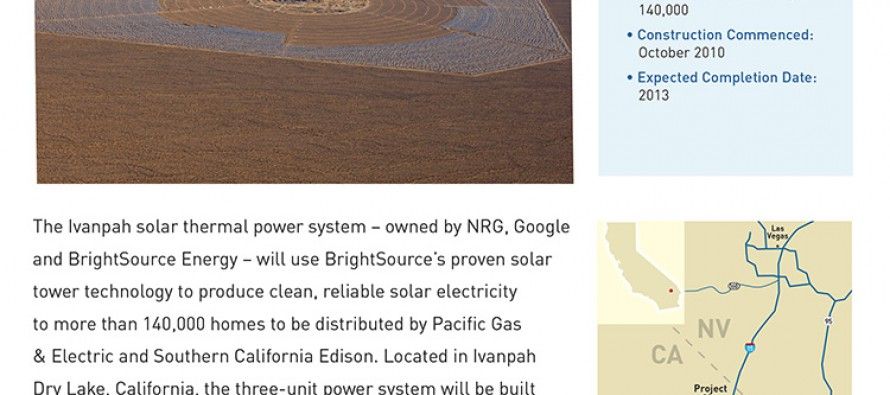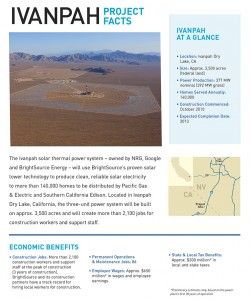Ivanpah solar plant bets on wrong technology

 U.S. Energy Secretary Ernest Moniz was in the unincorporated San Bernardino County community of Nipton Thursday, where he dedicated the new $2.2 billion, 392-megawattt Ivanpah Solar Electric Generating System (SEGS).
U.S. Energy Secretary Ernest Moniz was in the unincorporated San Bernardino County community of Nipton Thursday, where he dedicated the new $2.2 billion, 392-megawattt Ivanpah Solar Electric Generating System (SEGS).
“The Ivanpah project is a shining example of how America is becoming a world leader in solar energy,” said Moniz. It “shows that building a clean energy economy creates jobs, curbs greenhouse gas emissions and fosters American innovation.”
Moniz’s boosterish remarks sound very much like the giddy comments made by his immediate predecessor, former Energy Secretary Steven Chu, when he was in Freemont in 2009 to dedicate the Solyndra solar panel manufacturing plant.
Chu predicted Solyndra’s new plant would “kick off many more” such groundbreakings by clean energy companies, which would usher in “the second industrial revolution.”
However, in 2011 Solyndra went belly up, taking $535 billion in the federal taxpayers’ subsidies with it. While the start-up solar panel manufacturer’s copper indium gallium diselenide (CIGS) thin-film technology worked well enough, it simply was not economically competitive with conventional, flat silicon panels.
Ivanpah Solar, which was gifted a whopping $1.6 billion federal loan guarantee, has run in to the same problem as Solyndra – its technology is far more expensive than competing technologies.
Indeed, SEGS uses solar thermal power to produce its 392 megawatts. Its “generating system” has more than 300,000 “heliostats” – mirrors to the lay public – spread over 5.5 square miles in the Mohave desert.
The heliostats reflect sunlight onto boilers atop three towers, each of which is reportedly 150 feet taller than the Statue of Liberty. The entire complex is said to be visible from the International Space Station.
PV technology
Yet, even the companies that jointly own Ivanpah Solar – BrightSource Energy, NRG Energy and Google — acknowledge that their $2.2 billion clean energy venture has been undercut by photovoltaic technology, which has fallen significantly in price in recent years.
“There’s no doubt,” said NRG Chief Executive Officer David Crane, “in terms of price competitiveness, solar photovoltaic is cheaper.” It represents the future of solar energy, he suggested, not solar thermal generating systems, like Ivanpah.
“What really gets me excited in the morning,” he said, “is that there are 50 million American buildings that should have solar PV on them.”
Quite unintentionally, Crane has made a persuasive argument against government subsidy of clean energy.
The U.S. Energy Department bet $535 billion on CIGS, the technology Solyndra employed to manufacture its thin-film solar panels when the market went with conventional, flat silicon panels.
And Moniz’s department bet $1.6 billion on solar thermal power, the tech used by Ivanpah Solar Energy Generating System, when solar photovoltaic is shaping up as the marketplace winner.
Related Articles
Sunset state agencies?
APRIL 12, 2010 By STEVEN GREENHUT Sen. Dennis Hollingsworth, R-Murrieta, has introduced legislation, on behalf of the Schwarzenegger administration, that would
Do they really want to combat global warming?
Commentary Oct. 31, 2012 By John Seiler Nowadays, almost anything that happens is blamed on “global warming.” Or its more
Brown’s ‘Denier’ website forced to remove fallacious chart
Aug. 21, 2012 By Wayne Lusvardi Science is on nobody’s side in the contentious debate about “global warming.” That is


